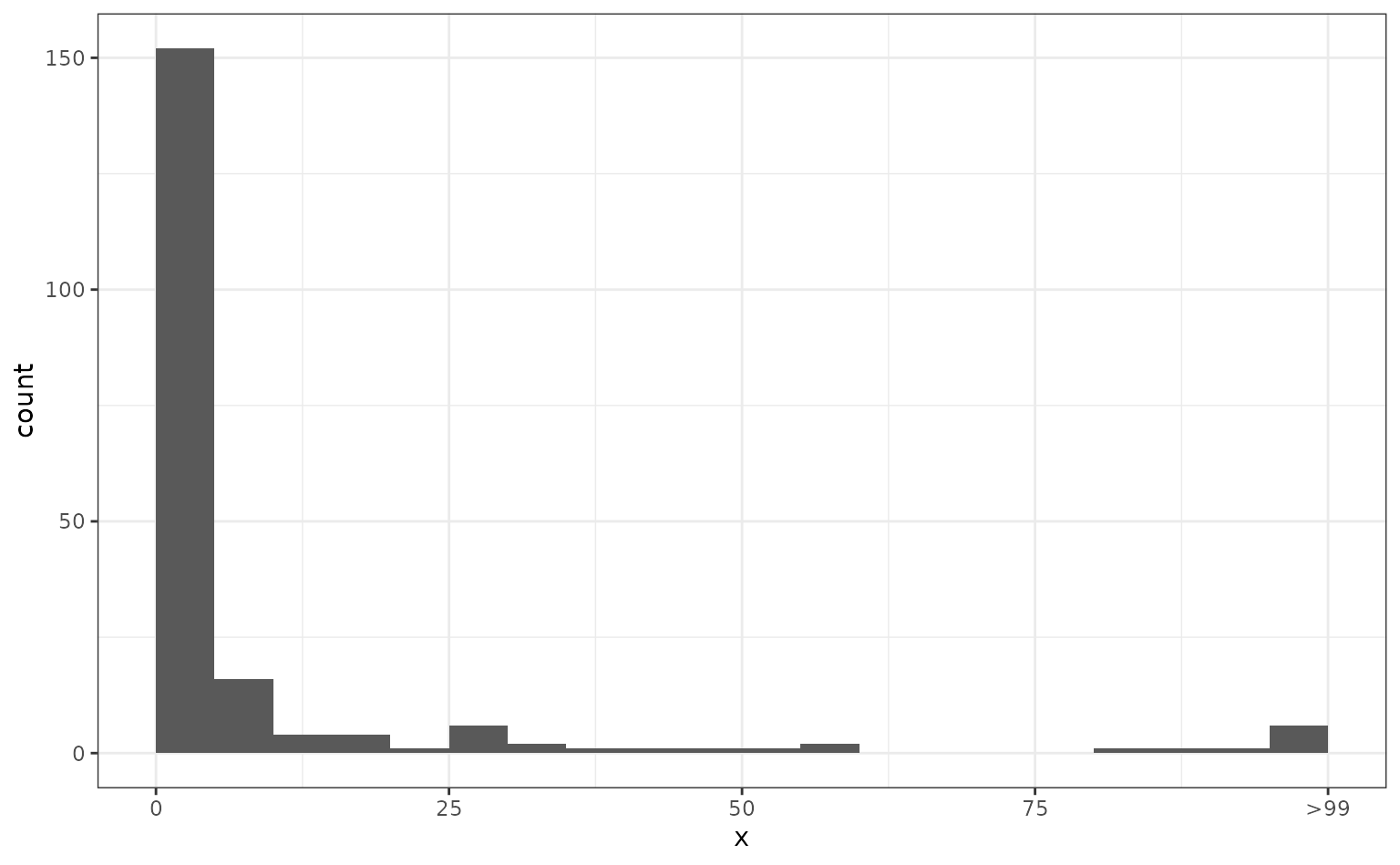Modelling disease control interventions
Sebastian Funk and James M. Azam
Source:vignettes/interventions.Rmd
interventions.Rmdepichains does not provide any direct functionality for
studying reductions in transmission (e.g. from public health
interventions). However, the flexible simulation functionality that it
includes can be used to consider some specific changes to the parameters
that can be interpreted as the result of changes in social behaviour or
control measures. Here we investigate the effect on outbreak sizes, but
the same approaches could be used for investigating chain lengths (using
the statistic argument to
simulate_chain_stats()) or the time progression of
outbreaks (using the simulate_chains() function).
Some of the ideas presented here can be achieved using closed-form solutions of the probability of an epidemic growing out of proportion or going extinct, and the impact of heterogeneities in individual-level transmission. For examples of this, see the vignette on epidemic risk in the superspreading package, which is part of the Epiverse-TRACE Initiative.
## main package
library("epichains")
## for plotting
library("ggplot2")
## for truncating the offspring distribution later
library("truncdist")As a base case we consider the spread of an infection with a negative binomial offspring distribution with mean 1.2 and overdispersion parameter 0.5. We simulate 200 chains tracking up to 99 infections:
sims <- simulate_chain_stats(
n_chains = 200, offspring_dist = rnbinom, stat_threshold = 99, mu = 1.2,
size = 0.5, statistic = "size"
)We then plot the resulting distribution of chain sizes
sims[is.infinite(sims)] <- 100 # Replace infections > 99 with 100 for plotting.
ggplot(data.frame(x = sims), aes(x = x)) +
geom_histogram(breaks = seq(0, 100, by = 5), closed = "left") +
scale_x_continuous(
breaks = c(0, 25, 50, 75, 100),
labels = c(0, 25, 50, 75, ">99")
) +
theme_bw()
Reducing the strength of transmission
Following (Lloyd-Smith et al. 2005) we consider two ways in which disease control interventions can reduce the reproduction number: population-wide and individual-specific control.
Population-wide control
By population-level control we mean an intervention that reduces the
mean number of offspring (i.e. the reproduction number) by a fixed
proportion. For example, to reduce R by 25% at the population level we
scale the mu parameter from 1.2 to 0.9:
sims <- simulate_chain_stats(
n_chains = 200, offspring_dist = rnbinom, stat_threshold = 99, mu = 0.9,
size = 0.5, statistic = "size"
)
sims[is.infinite(sims)] <- 100 # Replace infections > 99 with 100 for plotting.
ggplot(data.frame(x = sims), aes(x = x)) +
geom_histogram(breaks = seq(0, 100, by = 5), closed = "left") +
scale_x_continuous(
breaks = c(0, 25, 50, 75, 100),
labels = c(0, 25, 50, 75, ">99")
) +
theme_bw()
Individual-level control.
In simulating population-level control we now apply the same reduction as before (25%) but instead of assuming that the mean is reduced we apply this such that 25% of individuals do not transmit further at all, whereas the remaining 75% generate offspring as in the uncontrolled case.
To do this, we can no longer use the standard negative binomial
distribution that comes with R. Instead, we define a random generator
from a modified negative binomial distribution that includes our
individual-level control as a control argument indicating
the level of individual-level control (0: no control; 1: full
control):
rnbinom_ind <- function(n, ..., control = 0) {
## initialise number of offspring to 0
offspring <- rep(0L, n)
## for each individual, decide whether they transmit further
transmits <- rbinom(n = n, prob = 1 - control, size = 1)
## check if anyone transmits further
if (any(transmits == 1L)) {
## for those that transmit, sample from negative binomial with given
## parameters
offspring[which(transmits == 1L)] <- rnbinom(n = n, ...)
}
return(offspring)
}Having defined this, we can generate simulations as before:
sims <- simulate_chain_stats(
n_chains = 200, offspring_dist = rnbinom_ind, stat_threshold = 99, mu = 1.2,
size = 0.5, control = 0.25, statistic = "size"
)
sims[is.infinite(sims)] <- 100 # Replace infections > 99 with 100 for plotting.
ggplot(data.frame(x = sims), aes(x = x)) +
geom_histogram(breaks = seq(0, 100, by = 5), closed = "left") +
scale_x_continuous(
breaks = c(0, 25, 50, 75, 100),
labels = c(0, 25, 50, 75, ">99")
) +
theme_bw()
Preventing superspreading events
Another way of controlling a disease would be to prevent individuals from spreading to a large number of others, for example by preventing mass gatherings or, more generally, settings where superspreading events can occur.
We can model this by truncating the offspring distribution at a certain size. This can be done, for example, using the truncdist R package. We use this to define a truncated negative binomial offspring distribution:
rnbinom_truncated <- function(n, ..., max = Inf) {
return(rtrunc(n = n, spec = "nbinom", b = max, ...))
}We use this to simulate chains in a situation where the maximum of secondary cases that each infected person can generate is 10. This can be likened to a disease control strategy where gatherings are limited to 10 people.
sims <- simulate_chain_stats(
n_chains = 200, offspring_dist = rnbinom_truncated, stat_threshold = 99,
mu = 1.2, size = 0.5, max = 10, statistic = "size"
)
sims[is.infinite(sims)] <- 100 # Replace infections > 99 with 100 for plotting.
ggplot(data.frame(x = sims), aes(x = x)) +
geom_histogram(breaks = seq(0, 100, by = 5), closed = "left") +
scale_x_continuous(
breaks = c(0, 25, 50, 75, 100),
labels = c(0, 25, 50, 75, ">99")
) +
theme_bw()
Truncating the generation interval
Lastly, we consider a situation where the generation interval is shortened. We do not model this explicitly but instead consider the effect on the offspring distribution.
For example, if our generation interval is from a gamma distribution with shape = 25 and rate = 5 (corresponding to a mean of 5 and standard deviation of 1), and we stop all transmission that would normally occur more than 6 days after infection, we can calculate the proportion of transmissions that are prevented as
In other words, this would prevent 16% of infections in this example.
The value of control can be used in the examples above to
study the effect on outbreak sizes.